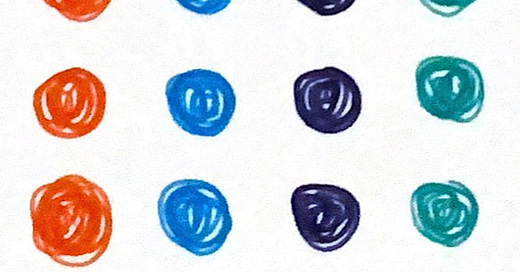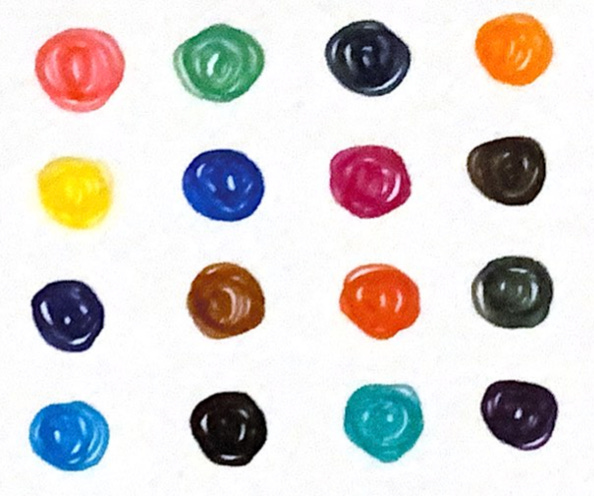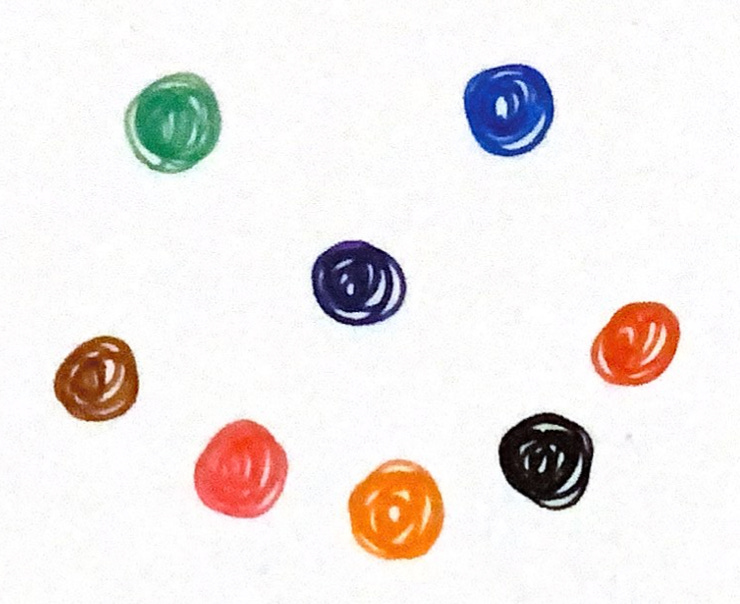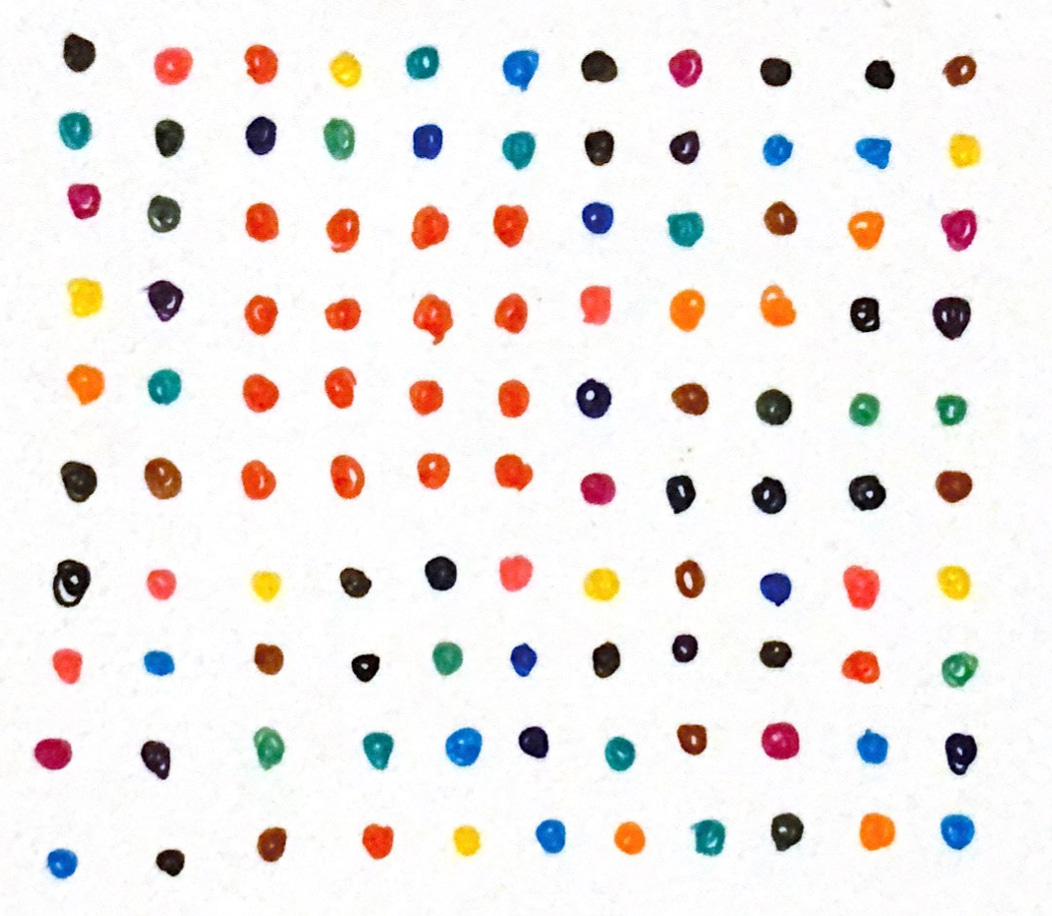Let Me Prove a Point Using Colored Dots
Come play with me with diversity at several levels of abstraction! 🔴
Hello friends!
This is Light Gray Matters #22. Last week, I made a list of the many ways humans, living beings, and random inanimate matter can be diverse. This week, we’ll keep exploring the idea of diversity, but in a more abstract way.
Consider this picture:
A set of 16 dots, all the same color and shape. Within the picture, there is no diversity; only uniformity.
Now consider this one:
No two dots are the same color. On the dimension of color, this set of 16 dots is maximally diverse (in the world of sets of 16 dots).
Which of these two pictures is more attractive? Don’t overthink this. Just notice your raw, immediate feeling. Which picture is more interesting? Which did you spend more time looking at?
Your mileage may vary,1 but I’d bet the second picture is the answer for most people. It is, for me. Why might that be?
Well, first, it does seem like we’re attracted to colors in general, for whatever evolutionary psychology reason. But more fundamentally: The colorful picture contains more information.
In the first picture, looking in detail at each dot will teach you nothing after the first one, since they’re all the same. In the second, you could spend some time on each to fully understand the 16 colors.2 There’s also the possibility that the colorful set encodes some interesting pattern.3 It takes only a glance to realize that the uniform set contains no hidden pattern.
That’s what diversity is, in a sense: a higher amount of information within a group of things.
But too much information can be, in a sense, as bad as not enough. The colorful picture is a bit chaotic. It lacks order.
Here’s a set of dots that contains a better dosage of diversity, organized in a clearly recognizable pattern:
Humans are fundamentally pattern recognizers. We easily notice this stuff, and we’re attracted to it. The term pareidolia describes this tendency to see objects and patterns in many situations, such as in this set of eight dots that remind everyone of a face even though a human face doesn’t look like this at all, when you think about it.
There are no patterns to be recognized in perfect uniformity. Neither in perfect diversity — perfect chaos.
At the level of the individual dot, this doesn’t matter. Diversity is great, because each dot can contain new information. But at the level of the 16-dot set, an intermediate level of diversity is better than maximal diversity. Why? Because there are more possible patterns at intermediate levels.
Let’s forget about colored dots for a second and consider 0s and 1s, as in computer science. Suppose we have a sequence of 8 symbols (a.k.a. a byte).
How many ways are there to have only 0s? One: 00000000.
How many ways are there to have only 1s? One: 11111111.
How many ways are there to have a perfectly balanced set of 0s and 1s? There are 70 ways: 00001111, 00010111, 00100111, etc. Thus there is much more information in the intermediate forms.
This can get a little confusing. 0s and 1s contain no information by themselves, so only the patterns (one level of abstraction higher) are important. Our colored dots from earlier — or people in a group, or animals in an ecosystem — contain intrinsic information, so diversity at the individual level matters just as diversity at the pattern level does. Level is the keyword here.
To further illustrate this: here are two larger set of dots. Which part strikes you as the most interesting in each?
Most likely, in both cases, you noticed the cluster of red dots more than anything else.
The 16-dot uniform was boring, on its own, at the beginning of this post. Now it is somehow the most interesting part of those pictures, because it breaks the larger patterns (randomness in the first case, a colored sequence in the second).
Order can be unusual and interesting when it contrasts with chaos. Uniformity, when it contrasts with diversity. And this creates diversity at the higher level.
One last example: Imagine a very messy house, hoarder-style. Every room is full of an oppressive diversity of random shit, boxes, books, furniture piled upon furniture, and so on. Then, in the middle, there is a room that’s almost empty. Minimal furniture, white walls with nothing on them, and a single, clean window.
That room breaks the pattern of the house, and make it more diverse and more interesting. But a house that would consist of only minimalist rooms like this would be boring. Unless you were used only to hoarder houses and this house broke the larger pattern of house diversity (as opposed to room diversity)…
All right, I think by now you get the idea. Humans are interested in information (patterns). Diversity means more sources information. But the distribution of diversity is also a source of information. This can be viewed at several levels.
Where am I going with this?
One answer is: I don’t quite know yet. Another is: there’s a secret master idea riiiiiight around the corner. Yet another answer is: you’ll see next week.
Until then I remain
Yours in the abstract,
Étienne
P.S. Last week, I published the second part of my essays about friendship! It is about friendship maintenance:
P.P.S. Don’t hesitate to subscribe/share this newsletter. Not that I care that much, but hey, more readers = more motivation!
One possible confounding factor: bright colors are more attractive than dull ones, and the all-red picture is brighter on average than the multicolored one.
Well, okay, this is a toy example and there isn’t much to learn from colors, but you get the idea.
There isn’t one, but you don’t know that until you look or until I tell you.










